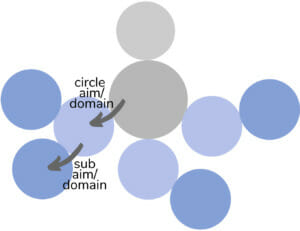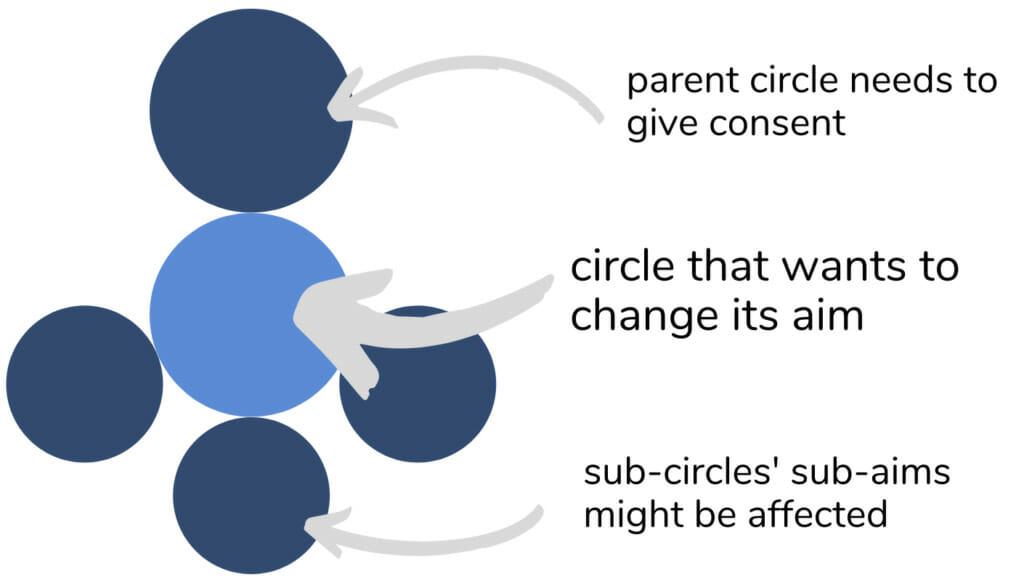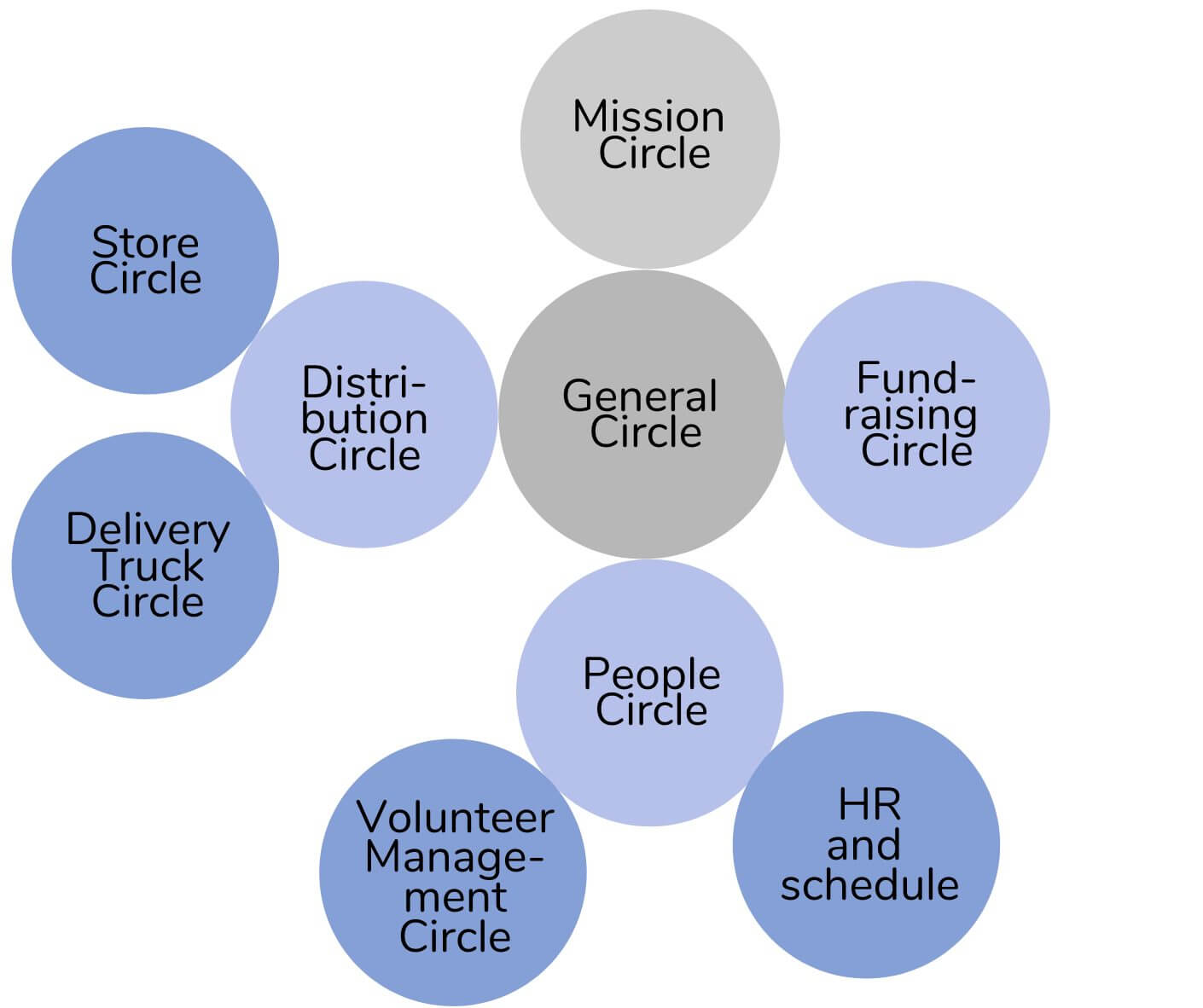Language: Français
Sociocracy uses vision, mission, and aims to clarify the goals of the organization and what you’re working towards as a group.
Introduction: vision and mission
Organizations exist for a reason: humans enjoy the sense of belonging and collaboration and form organizations to reach something they wouldn’t be able to accomplish alone.

Often, organizations form because the founder(s) have a vision of what they’d like to see in reality, like a world without hunger or education for everyone, a world where everyone belongs.
That vision – and the fact that it is not yet a reality – motivates us to form organizations. We decide to set out on our mission of making the changes necessary to close the gap between the world we have and the world we want. That mission becomes the why of our organization.
The mission of our organization will be somewhat broad and indicate what issue we’re going to focus on, like reducing hunger, providing education for everyone, promoting intentional communities – it speaks to the broader issue that the organization attempts to address.
| Vision | Mission (Example) |
| a world without hunger education for everyone world where everyone belongs | reducing hunger providing education for everyone promoting intentional communities |
Organizational aims
Let’s say we have a mission “to feed the hungry.” Where do we even start? This mission is not actionable because it’s too big and unspecific to act on it. That’s why we need aims. Aims are concrete descriptions of things that we can act on.
| Vision | Mission | Aim |
| a world without hunger | to feed the hungry | running a food bank in Amherst MA |
| education for everyone | to provide education for everyone | Offering an affordable afterschool program in Chattanooga |
| world where everyone belongs | to promote intentional communities | writing blog articles about ecovillages in Latin America |
In that, the aim describes what the organization is actually going to do to work towards its mission. A good test on whether we’ve described the aim is this: if your great aunt asks how you spend your time in the organization, and you say, “we are reducing hunger,” she will most likely not have a clue what you do. If you say, “We run a food bank in Amherst, MA,” it will be much more apparent. That shows the difference between a mission and an aim – the former is inspirational, the latter is actionable.
Circle aims in sociocracy
The aim for the whole organization is carried out by different circles, each taking on a piece. In this way, the organizational aim gets divided up into circle (sub)aims in a fractal manner. The aims now get more and more specific on each level, for example, going down to “purchasing and preparing snacks for the afterschool program.”
In addition to aims, circles have domains defining their scope of responsibilities and authorities. A circle’s domain should encompass what’s needed to achieve its aim. As a simple example, it’s most empowering to task a circle with the aim of cooking lunches for a school if we also give that circle the authority to use and maintain the kitchen.

How you find your aim in sociocracy
A simple prompt to find an organization’s aim is to ask: why does your organization exist? Typically, people’s response will be their mission: “Because we want to raise awareness about climate change.”

How we’re going to do that can be expressed in a “by”-phrase. Example: “We want to raise awareness about climate change by conducting science projects that explore climate science with elementary students.” Or: “We want to raise awareness about climate change by writing articles about climate change for a general, progressive audience.” The by-phrase gives you the aim.
If your aims stay vague, your circles won’t know what the wider organization is tasking them with and might struggle to operationalize it. It’s almost best to over-specify because that’s easier to detect than aims that are under-specified. For example, in the above aim, if the organization decides to work with middle school students in addition to elementary school kids, the aim would need to be broadened. Yet, if the aim is underspecified – for example, “writing articles about climate change,” then the organization will spend a lot of time arguing where to publish and what our target audience will be.
From the overall aim to circle aims

A good prompt to go from the organizational aim to circle aims is to ask, “what needs to be done so you can achieve your overall aim?” Typically, people will mention 4-12 aims that then can be clustered into aims and sub-aims. (This video series leads you through drawing a circle structure!)
What if we need to change our aims in sociocracy?

Aims in sociocracy are not set in stone. The basic design principle is that aims are approved locally, which means the parent circle needs to consent to the aim change as well as all sub-circles who are affected by the change. (To change an organization’s overall aim, the Mission Circle and the General Circle need to consent.)
From here, it’s all easy. All we need to do is put the aims and domains into a table that corresponds to the circle structure. You can see an example table and a corresponding circle diagram below.

| Name | Aim | Domain | |
|---|---|---|---|
| Distribution Circle | Receiving and distributing items to those who need it. | Stocks, storage space, cooling room; contact to donor stores | |
| Store Circle | Offering a fully stocked walk-in store accessible to all. | Store space. Fridge. Counter space. | |
| Delivery Truck Circle | Delivering items into distribution points. | Truck. Driver schedules. | |
| Fundraising Circle | Raising funds for the organization. | Donor management system | |
| People Circle | Maintaining a welcoming and well-run working space to keep the food bank running. | Membership policies. Mailing list (CRM). | |
| Volunteer Management Circle | Attracting and onboarding volunteers, incl. running open houses. | Volunteer schedule. Volunteer policies. | |
| HR and schedule | Providing a healthy, safe and caring work environment for all staff. | All HR policies and processes Job listings. Insurance. | |
| General Circle | Supporting circles and negotiating aim/domains of circles. | Budget | |
| Mission Circle | Holding the organization true to its mission to feed the hungry Operationalizing the mission into aims. |


Leave a Reply
You must be logged in to post a comment.